
In Japan, people do not usually make sushi at home. Sushi bars are nearly ubiquitous there, and the Japanese often feel that only an expert sushi chef can make proper sushi. When they eat sushi at home, they order it. However, for special events, making sushi at home can be fun and delicious.
Choosing the Right Fish
If you use raw fish in your sushi, buy it from a trusted source. Terms like "sushi-grade" and "sashimi-grade" aren't regulated by law. The U.S. Food and Drug Administration provides guidelines on freezing raw fish to make it safe for consumption, but it's up to local governments to enforce the guidelines.
Advertisem*nt
When you find the right kind of fish, ensure it's fresh. Fresh fish smells clean, not fishy. If the fish is whole, it should have clear eyes and firm, attached scales.
If you're looking at fillets, watch out for discoloration and soft spots — these are all signs of less-than-fresh fish. Some fish, notably salmon, are flash-frozen on the boat. If you don't live near the ocean, you may not be able to find fresh sushi-grade fish.
Be sure to thaw frozen fish in the refrigerator before use.
Preparing the Rice
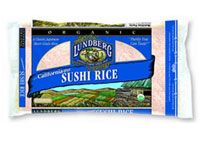
The rice itself can be any white medium or short grain rice, but Asian food markets sell rice that is labeled "sushi rice."
Rinse the rice until the water runs almost clear from the rice. Do this carefully to avoid mashing or breaking the rice. A strainer can be too rough, but gently swirling water around the rice in a pot works well. Then, soak the rice in cold water for half an hour, and drain it again.
You can add a little sake (Japanese rice wine) and a piece of dashi konbu, dark green dried kelp, to the rice before cooking.
Bring the rice to a boil and cook it on medium heat with the lid on the pot for 15 minutes, then simmer for another 20 minutes or so over low heat. When the rice is done, turn the heat to up to high for a few seconds. Once the heat is off, let the rice sit for 15 minutes.
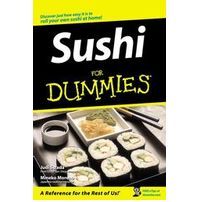
While the rice is soaks and cooks, you can prepare the vinegar. Asian markets sell bottles of premade sushi vinegar, but making it yourself is easy. You start with rice vinegar — no other kind will work. Then add sugar and salt.
In their book "Sushi for Dummies," authors Judi Strada and Mineko Takane Moreno recommend ¼ cup of vinegar, 1 tablespoon of sugar and 1½ teaspoons of salt for five cups of rice. Stir these ingredients until the mixture is clear. You can refrigerate the seasoned vinegar, but it should be room temperature when added to the rice.
Mixing the rice and the vinegar is slightly more complicated than simply dumping and stirring. First, the rice must be "turned out" into a bowl. Traditionally, a flat wooden bowl is used, but any glass or plastic bowl will work (metal would react with the vinegar). A low-profile bowl will allow the rice to cool evenly.
"Pry" the rice out of the pot with a spatula or a wooden sushi paddle moistened in the vinegar, tipping the pot upside down and slipping the rice into the bowl. Remember to take out the dashi konbu. Then, hold the paddle over the rice and slowly pour the vinegar over it. Move the paddle around over the rice to evenly distribute the vinegar.
Stir the rice by gently dividing it with the paddle and turning it over. At the same time, wave a fan briskly over the rice to help it cool quickly. When the rice stops steaming, you can stop turning and fanning. Cover the rice with a moist towel and keep it at room temperature until you are ready to assemble the sushi.
Making Nigirizushi
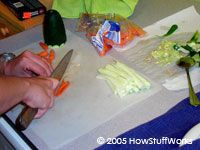
These photos and instructions will show you how to create some of the more common varieties of sushi. Keep in mind that we aren't sushi experts — we were learning how to do it, too. For toppings, we used thinly sliced carrots, avocado and cucumber.
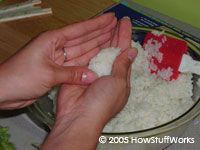
Toppings need to be sliced so they'll fit into or on top of the sushi. The slicing is an art form all by itself. Toppings can be diced, minced, shaved, slivered, or cut into matchsticks. Here we have carrot slivers and long cucumber slices.
Finger sushi, or nigirizushi, is made by forming a small morsel of rice into an oblong shape. Dip your fingers into vinegar water first, then shape the rice in the palm of your hand. Don't squeeze the rice together too hard; just apply enough pressure to make the grains stick together.
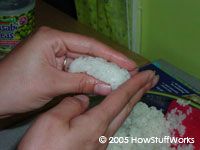
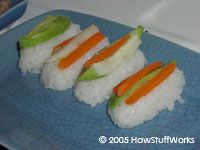
Use your thumb to make a small indentation on one side of the sushi. This side will be the bottom, so the piece of sushi should curve upward slightly in the middle when you set it down.
It's easiest to make several pieces of nigirizushi first, and then add the toppings. You can simply put the toppings on, or add a streak of wasabi first. These are the first pieces of sushi we made. They're not perfect, but they tasted good.
It will take some practice before your sushi looks as good as it tastes. You can also wrap a strip of nori could also be wrapped around each sushi piece, but if you serve sushi with nori, do so immediately, while the nori is still crisp.
Making Temaki
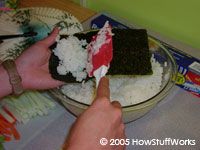
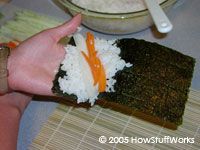
Now we will make a hand roll, or temaki. This is a cone of nori with the rice and toppings inside. Start with half a piece of nori. Temaki are easiest to make holding the nori in your hand. Spread rice onto one end of the nori, covering about a third of it. Place your toppings diagonally across the rice.
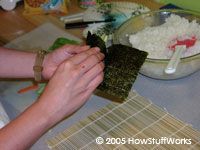
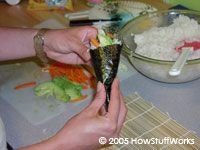
Fold the bottom corner up and over the toppings, then start rolling the nori in the same direction. When you finish rolling, you should have a cone-shaped piece of sushi. The moisture in the rice will help the nori stick together.
Making Makizushi
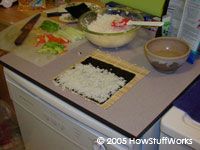
Makizushi is rolled sushi, and it comes in several varieties, depending on the exact shape and size.

Hosomaki and chumaki are what many people think of when they think "sushi": rice and other ingredients on the inside, nori on the outside. The difference between these two types of makizushi are that hosomaki only contains one ingredient (beyond the rice and nori) and chumaki includes two or more.
Futomaki is also a type of maki sushi that's rolled with the nori on the outside, but its girth is typically much larger and only contains vegetables.
In the pictured examples, we're making chumaki. To follow along, first put a sheet of nori on your bamboo mat, shiny side down. Cover about two-thirds of the nori with rice (probably a little less than pictured here). Place your toppings across the rice.
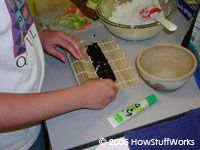
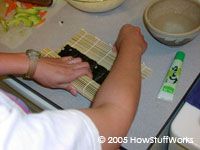
Fold the bamboo mat over, rolling the nori onto the toppings. Be careful not to roll the mat into your sushi. When the mat touches the far edge of the rice, begin tightening the roll.
Hold the roll with the mat over it, and grab the far edge of the mat. Pull on it at each corner and in the middle to tighten the roll. When the roll is tight enough, finish rolling by pulling the mat forward. You can repeat the tightening process first if you need to.
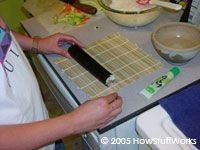
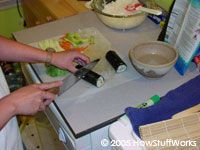
Now you have a complete futomaki roll. Slice the roll in half with a very sharp knife, pressing straight down through the roll to avoid tearing the nori. Slice each half twice more to end up with eight pieces of makizushi.
Making Uramaki
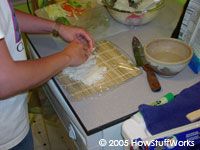
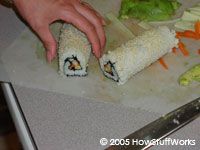
Inside-out rolls, or uramaki, are made just like chumaki, but you start with a piece of plastic wrap over the bamboo mat, and spread the rice directly onto it. Then add the nori over the rice, with the toppings placed on top of the nori. Roll it exactly like futomaki.
You can cover the completed roll in sesame seeds or another garnish before slicing.
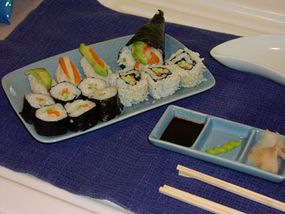
A variety of sushi looks very appealing and makes a great hors d'oeuvre (or even a full meal on its own). Don't forget the soy sauce and wasabi for dipping, and ginger root for cleansing the palate between pieces of sushi.
Advertisem*nt